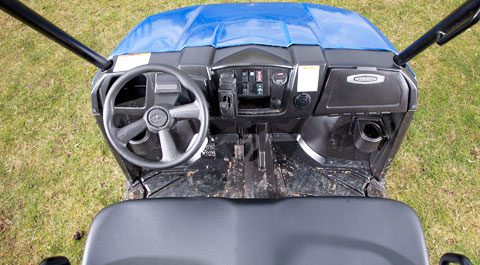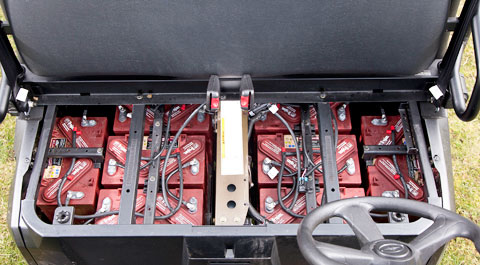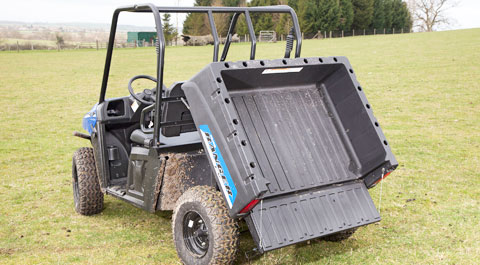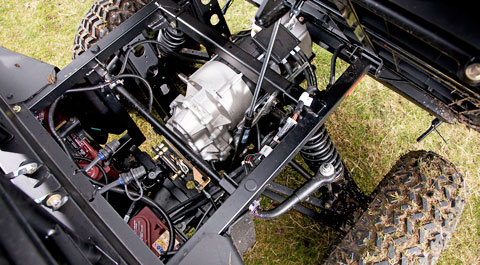Video: Electric ATV test: Polaris Ranger EV
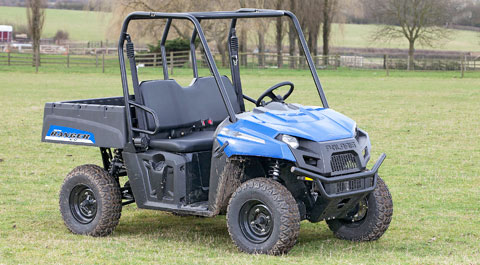
Polaris is by far the biggest company pushing electric versions of its utility vehicles. It’s made the most of big company perks to build a well-finished UTV that seems capable of doing everything required.
It’s quick and strong, and is probably best placed of all the test vehicles to step straight onto a farm.
Watch the video and read the full report below.
North American ATV giant Polaris first introduced the electric version of its tried and tested mid-sized Ranger utility vehicle in 2009. It was the first big company to take the plunge into battery power, designed to be capable of a decent days work. It has also proved popular for hunting duties and shuffling people to and fro on large estates.
Our first impressions were mixed. It lacked the sporty edge of the Avid and certainly wouldn’t survive a bomb blast quite like the military-style Ausa might.
But the royal blue and black colour scheme is easy on the eye (fortunately so as it’s the only choice).
Our test vehicle was also missing a front screen and roof, leaving us at the mercy of the Warwickshire weather. Still, you’d probably opt for both when it comes to actually buying one.
A bench seat means you can swing in and out of the cab rather like a chimp in the Amazon. There’s no clutter either – flick switches are stacked neatly and the handbrake is on the dash out of the way.
Round the back is an easy-to-get-to towbar. The rear load bay is plastic but very sturdy (Polaris was probably wary of adding any more load to something that already weights almost as much as a Charolais bull). The rear tray is supported by gas struts which take the arm work out of tipping (there’s no electric tip option).
There are eight lead-acid 12v batteries tucked under the bench seat. Easily accessible, they have a handy watering system with a colour indicator to show when the water level is getting low and needs a top-up.
Powering both front and rear wheels is a big, single 30hp/48V AC-induction motor. Tucked under the load bay, the motor sends drive directly to the rear diff and via a prop shaft to the front wheels.
Charging is very simple. An inverter is tucked under the bonnet (rather than separately), so it really is just a case of swinging up to the nearest socket and plugging it in to re-fuel. When not used, the plug is stored in the glove box so everything you need for charging is onboard.
Polaris says the Ranger EV will manage 50 miles (depending on terrain). We fancied our chances of running it flat over an afternoon, but while the Avid began to wane, the Ranger was still charging around. It would probably have volunteered to tow the Avid home had we not called it a day.
Starting
While some of the other test vehicles were guilty of some woefully tedious and confusing start-up arrangements, the Ranger’s was a simple combination of key and flick switch.
Stamp on the throttle and the get-up-and-go of the Ranger might take you by surprise (the first couple of times at least). It will get up to top speed – about 25mph – almost instantly, but stays eerily quiet. Even at full pelt, the hum was almost quieter than the hedgerow birds, resembling something half way between a whirr and whistle. It was by far the quietest of the test crowd and would be ideal for any stalking duties.
Controls
On the controls front, the EV has benefitted from some ‘big company’ perks – the dash and plastics have been produced solely for the Ranger, for instance. It means all the controls are where you would expect them to be.
On the dash there’s an hour meter, hand brake and seemingly accurate battery life indicator, so you always have a reasonable idea of how much go is left in the batteries.
Driving performance
There’s not a road-ready version of the Ranger. In the field it’s pretty nippy in all three ranges – there’s ‘high’ for speed, ‘low’ for towing and a ‘max’ setting to get the most out of the batteries.
Driving is smooth, too. There’s certainly none of the teeth chattering caused by a juddering diesel and there’s something quite therapeutic about scooting around on the Ranger EV.
Manoeuvrability
The Ranger has on-demand 4wd – automatically engaging all four wheels when you need more forward traction and reverting back to 2wd when you don’t. But even turning sharp corners with 2wd engaged tends to tear up the ground like a rooting large white boar. The single-wheel drive versatrac mode unlocks the rear diff for easier, tighter turns that avoid making such a mess.
Good ground clearance of 25cm makes travel and straddling higher ground easier as well.
Suspension and braking
Underneath its plastic bodywork, the EV shares the same chassis as the popular Ranger 400. There is independent suspension all round, with 9in of travel on the rear and 8in at the front. There’s also five-point adjustable preload so you can stiffen the suspension for heavy loads.
When it comes to stopping, some meaty-looking hydraulic disc brakes on all four wheels makes pulling up pretty sharp.
Towing capacity: 567kg
Payload: 227kg
Motor: 30hp 48-Volt AC
Transmission: Low, high and max distance ranges
Range: 35-45 miles
Batteries: 8
Total battery life:1,000 charges
Price: £9,899
• See the Polaris website for more details


